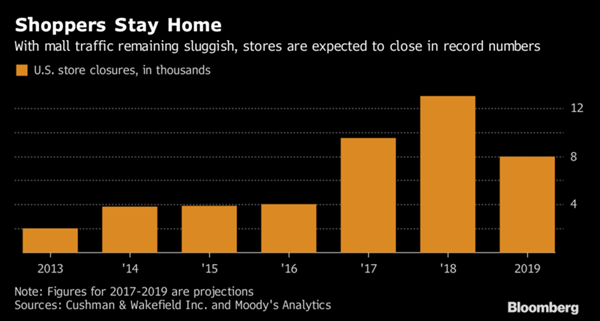The Migration from Brick-and-Mortar to Online Stores
2017 turned out to be a profitable year for online retailers as commerce revenue surged to  $108.15 million in 2017, from $94.4 million in 2016, according to Adobe’s analysis of one trillion visits to over 4,500 retail sites and 55 million SKUs. Online retailers did a much better job at keeping people on their sites too as visit duration increased by 1.2% year-over-year (YoY).
$108.15 million in 2017, from $94.4 million in 2016, according to Adobe’s analysis of one trillion visits to over 4,500 retail sites and 55 million SKUs. Online retailers did a much better job at keeping people on their sites too as visit duration increased by 1.2% year-over-year (YoY).
Unfortunately, it is hard to say the same for store sales. 2017 kicked off with 2,880 store closures and nine retail bankruptcies announced in the first three months, and the year ended with nearly 7,000 store closure announcements, which was up more than 200% from a year ago. U.S. department stores were affected by this wave the most, comparing to their retail peers. Far worse, the new wave (maybe even a tsunami) of closure announcements have already been speculated to hit in 2018. To be exact, more than 12,000 closures are expected to be announced and another 25 major retailers could file for bankruptcy this year, according to the commercial real estate firm Cushman & Wakefield. Big names like Walgreens, The Gap, and Gymboree have already announced plans to close more than 3,600 stores this year.

The economy is not the culprit for a slew of retail bankruptcies and closures, as some would like to believe. Although there are many factors that drive this trend, the most common reasons include:
-
The areas of consumer spending have been drastically changing
-
As digital transformation continues to engulf everything in its path, opportunities and challenges will equally get off the ground.
- The US market is oversaturated with retail space so the bubble manufactured by American retailers has finally burst. (The number of malls in the U.S. grew more than twice as fast as the population between 1970 and 2015.)
How Should Brands Reinvent Themselves in 2018?
Harness the Power of Location Data
The fact that brick-and-mortar earnings are in a blood-bath is the strongest driver behind a  tremendous amount of interest and enhancement in location-based advertising and marketing. What makes these technologies beneficial is that marketers and merchandisers can now measure their ad effectiveness based on foot traffic through a location social app and provide attribution insight based on the action that ads drive at specific locations.
tremendous amount of interest and enhancement in location-based advertising and marketing. What makes these technologies beneficial is that marketers and merchandisers can now measure their ad effectiveness based on foot traffic through a location social app and provide attribution insight based on the action that ads drive at specific locations.
To trigger local offline conversions, brands need to harness the power of location data. Therefore, the location-based marketing spend is expected to continuously grow at an annual compound growth rate of 24.6% from almost $10 billion in 2015 to $29.5 billion in 2020, according to BIAKelsey. Also, the “Global Location Trends Report” suggests that 75% of 253 global marketers, including Starbucks, BMW, and Coca-Cola, believe that location-based marketing will play a crucial role in their businesses. It’s no wonder, the Silicon Valley titans are rushing to add those capabilities through acquisitions such as Apple’s acquisition of Quattro Wireless, Google’s acquisition of AdMob, and AOL’s acquisition of Millennial Media.
The location data tells a whole lot about consumer behavior, so much so that even without directly passing on your customers through notifications and such, it is still very valuable to understand a target audience as it lights up the customer journey by drawing the pattern and relation, say, between their visits and an ad previously seen. That way, the sales window wouldn’t be closed, even after a customer leaves the store empty-handed, retail would still have the chance to pull the customer back with personalized offers generated based on that data.
Ultimately, when it is combined with other insights, the location-based data help businesses with better tailor ad exposure, and optimize channel spend, site selection, and inventory planning. According to Rob Murphy, VP of marketing at Swirl, an indoor mobile marketing software provider, retailers who use indoor mobile location technology are seeing upwards of 20% increases in in-store purchase rate and conversion rate of the mall to store traffic, with ROI running as high as five to seven times the technology investment.
After all, using state-of-the-art analytical technologies is a prerequisite for thriving in customer experience. Being armed with predictive insights helps organizations uncover hidden opportunities and competitive threats - turning negative customer feedback into promotion, eliminating biased decision-making processes as they take the guesswork out of customer relationship, and gaining a broader view of their positioning against the competitors to name a few.
Digitized Pop-Up Stores
As mentioned earlier, digital transformation continues to engulf everything in its path,  opportunities and challenges will equally get off the ground. With the advent of technology, it is now possible to bring convenience, ease of use, personalization, process simplification, and the high level of comfort to the storefront through a smart dressing room where customers can create a profile with their phone number, a fully-tailored experience that recognizes the items that were tried on in the dressing room, which ones were purchased and which ones were left behind, or through “memory” mirror technologies led by RFID tags to let customers try on virtual outfits and place iPads in fitting rooms enabling customers to ask for help, read reviews, see what sizes are in stock, and so on.
opportunities and challenges will equally get off the ground. With the advent of technology, it is now possible to bring convenience, ease of use, personalization, process simplification, and the high level of comfort to the storefront through a smart dressing room where customers can create a profile with their phone number, a fully-tailored experience that recognizes the items that were tried on in the dressing room, which ones were purchased and which ones were left behind, or through “memory” mirror technologies led by RFID tags to let customers try on virtual outfits and place iPads in fitting rooms enabling customers to ask for help, read reviews, see what sizes are in stock, and so on.
Despite the power of smartphones, tablets and the increased investment in online sales, people still enjoy the experience of shopping and running their fingers over soft fabrics as much as they like convenience. So, the solution comes in the form of offline and online merging. eBay, ModCloth, Walmart, and Delta Airlines, for example, have all experimented with pop-up storefronts to use brick-and-mortar opportunities to advocate for their digital experiences.
Eddie Machaalani & Mitchell Harper, CO-CEOs of BigCommerce said: “By 2022, brick and mortar retail spaces will be little more than showrooms.” In a Forbes CIO Network post, Machaalani and Harper predicted that the shopping mall as we know it today will be much different 10 years from now, saying: “Instead of loading up carts with goods to purchase in store, consumers will try on or sample the products in store, quickly scan and purchase items they desire, and have them delivered to their homes within hours.” To back up this prediction, eBay, ModCloth, Walmart, and Delta Airlines, for example, have all experimented with pop-up storefronts to use brick-and-mortar opportunities to advocate for their digital experiences. Target, Nordstrom and Forever 21 are also opening more stores but testing smaller locations.
Speaking to CMS-Connected, James Norwood, Executive Vice President Strategy, CMO at  Episerver, shared his thoughts on where we will see the most innovation in the coming months: “The commerce ecosystem is becoming more complex every day, and we think brands are starting to understand that it’s not as simple as ‘online vs. brick-and-mortar.’ There are new, disruptive channels cropping up all the time, such as conversational assistants, and to keep up, marketers and merchandisers must be agile. The ‘set-it-and-forget-it’ mentality no longer cuts it. That being said, content is still king on every channel, and the content that matters most to consumers is increasingly visual and interactive, which has given rise to a lot of conversations in the industry about visual commerce, which is definitely the next frontier, and why capabilities like user-generated content and seamless content delivery are so crucial now.”
Episerver, shared his thoughts on where we will see the most innovation in the coming months: “The commerce ecosystem is becoming more complex every day, and we think brands are starting to understand that it’s not as simple as ‘online vs. brick-and-mortar.’ There are new, disruptive channels cropping up all the time, such as conversational assistants, and to keep up, marketers and merchandisers must be agile. The ‘set-it-and-forget-it’ mentality no longer cuts it. That being said, content is still king on every channel, and the content that matters most to consumers is increasingly visual and interactive, which has given rise to a lot of conversations in the industry about visual commerce, which is definitely the next frontier, and why capabilities like user-generated content and seamless content delivery are so crucial now.”
Tap into Consumer Obsession with Mobile and Social Media
In 2010, Apple Inc. co-founder Steve Jobs said: "Mobile advertising really sucks." And he had a point. For a long time, marketers haven’t fully taken advantage of mobile advertising in the way they should have, and they failed a bit at tapping into the reality of the situation that the data coming from a mobile device is the strongest indicator of who someone is and what they like or don't like. The main reason was that they had seen mobile advertising like traditional advertising so it took some time to go beyond the banner ads displayed on the gaming app. However, today, the technology started catching up and marketers got more informed on how to utilize the intersection of the physical and the digital by forming the connective tissue tying these elements together.
Today, shopping experiences go well beyond a logical assessment of available alternatives, rather, they have become guided and emotional activities. Therefore, on top of integrated marketing execution, delivering proactive customer service and interactive experiences has become imperative for businesses to remain in the game and drive sales. Women, for instance, who comprise 63 percent of all online buyers, are now looking for an interactive relationship with brands in addition to convenience. In other words, creating a sense of community drives online sales.
Another big driver is social proof. The profound impact of social proof on making purchases and decisions comes from the fear of missing out which is, scientifically, a form of social anxiety and also known as FOMO in pop culture. Marketers have been harnessing the power of authentic social proof through user-generated content that is created by consumers who are willingly sharing their reviews and opinions about brands’ products and services. In fact, 70 percent of consumers place peer recommendations and reviews above professionally-written content, according to a survey conducted by Reevoo.
Heike Young, Manager, Industry Strategy & Insights at Salesforce, pointed out the opinions of  influencers on social media seem to be growing in importance: "Social media-driven traffic to retailers’ mobile sites is firmly on the upswing, with a 42% increase in 2017, according to the Shopping Index. We know consumers increasingly look to social for influencer suggestions and inspiration from family and friends on what to buy next. But in 2018, we’ll see social’s influence on mobile traffic become even more pronounced as networks like Instagram make it simpler for consumers to visit a product detail page and browse mobile sites directly from social content. In fact, Commerce Cloud now has a pre-built integration that makes it easy for brands to create shoppable content on Instagram business accounts. And with more sites implementing Apple Pay (see how Wolverine Worldwide does it) and Android Pay on checkout pages or right on the PDP, expect the journey from “I saw it on Instagram!” to “It’s mine!” to get even shorter."
influencers on social media seem to be growing in importance: "Social media-driven traffic to retailers’ mobile sites is firmly on the upswing, with a 42% increase in 2017, according to the Shopping Index. We know consumers increasingly look to social for influencer suggestions and inspiration from family and friends on what to buy next. But in 2018, we’ll see social’s influence on mobile traffic become even more pronounced as networks like Instagram make it simpler for consumers to visit a product detail page and browse mobile sites directly from social content. In fact, Commerce Cloud now has a pre-built integration that makes it easy for brands to create shoppable content on Instagram business accounts. And with more sites implementing Apple Pay (see how Wolverine Worldwide does it) and Android Pay on checkout pages or right on the PDP, expect the journey from “I saw it on Instagram!” to “It’s mine!” to get even shorter."
Centennials (under the age of 21), aka digital natives, don’t engage in the traditional customer service channels (such as phone or email), but they still expect personalized interactions with brands that understand their needs. According to the survey results, more than 80 percent of Centennials value social media when it comes to making a purchase decision. To be more specific, 44 percent of Centennials find Instagram important, and 21 percent find Snapchat important in their purchase decisions. Keeping in mind that Centennials are largely influenced by content, the right social message should be personalized as well as valuable. In other words, you should promote quality and authenticity over price. If your messaging is focused on pricing, then, at least, you should provide seamless cross-channel experience with personalized offers that can be easily utilized via any channel of choice.
Integrated Marketing Links Online Marketing with Offline Sales
Integrated marketing has become a high priority for marketers to reach buyers in an increasingly complex consumer journey that stretches across numerous devices and channels, according to a study entitled "State of Integrated Marketing 2017: Mapping the Journey to Success", conducted by research firm 451 Research on behalf of PlaceIQ. The study suggests that “offline marketers are increasingly turning to search, social and in-app marketing to drive in-store sales.” In the meantime, “online marketers have increased their investments in television, print and outdoor channels with the realization that those channels are not only too big to ignore but offer sophisticated targeting options.”
Furthermore, the study found that for online marketers, the most important measurable goal is customer engagement while for offline marketers, it is brand loyalty. It is important to note that the companies that sell their products and services offline indicated that they see both online and offline engagement as equally important, meaning that even though online is not a channel for them to sell their goods, it is still a powerful instrument for them to drive foot traffic. Therefore, if you think the alignment between online and offline channels is important only for businesses that sell in mixed offline/online environments, you might be leaving money on the table.
Good News: Not All Retailers Are Doomed
On a positive note, there are also plenty of retailers across the U.S. that are growing their physical assets while others sink or struggle to stay afloat. Over 3,400 openings have been announced so far in 2017, according to FGRT. Dollar General, Dollar Tree, Lidl, Aldi, Ross Stores, and TJ Maxx are planning to open hundreds of new stores next year.
In May 2017, my coworker Laura Myers and I were fortunate enough to sit down with TJX’s Dan Bushlow to discuss their digital transformation in Boston. Before going ahead and watching the interview, let me give brief background information about the company for those who are not acquainted with it. The TJX Companies, Inc. is an American apparel and home goods company based in Framingham, Massachusetts. In the United States, the company’s stores are known by such popular names as T.J.Maxx, Marshalls, and HomeGoods. Recently a new concept, Sierra Trading Post was added. In Canada, the names are Winners, HomeSense, and Marshalls. In Europe, the names are T.K.Maxx and HomeSense.
Knowing TJX built a retail empire, we wondered if the organization was embracing e-commerce. Dan informed us that among the group companies, T.J.Maxx is the only one that has an e-commerce website. For the rest, the only e-commerce related activity is selling gift cards. Therefore, the organization is expecting to utilize online marketing tools to execute more sophisticated campaigns. As a first step, though, they formed a mobile app team as they plan to launch a mobile app in the upcoming months.
TJX's earnings season history remains impressive as the company reported positive surprise in all the last four quarters, making for an average positive surprise of 5.29%. The company called out its marketing as a reason for such positive growth. Last year, Kantar Media reported that TJX has been incrementally adding dollars to its marketing budget each year and spending is up nearly 40% since 2011.
Such gains are mostly due to its effective marketing campaign but also partly its in-store destination strategy where shoppers can always find an ever-changing assortment of bargains. This strategy doesn’t only give consumers a shopping itch but also protects its business from an intrusion on e-commerce giant Amazon’s territory. That being said, winning the discount game is not an easy task as we have recently read many failure stories coming from the off-price bandwagon which nearly every other department is jumping on. Macy’s, for instance, has been expanding its off-price outlets, called Macy's Backstage with a hope of getting their share from a consumer migration to lower-priced discount stores.
Beauty retailers such as Ulta and Sephora continue to set examples of the fastest-growing names while expanding their footprints. Additionally, the S&P 500 Retail ETF (XRT) is making up for many of the past months' losses.
Ending Notes
When you think of all these delicate dynamics in a customer journey, sometimes, it may feel like rocket science at first but the reality is much more positive than it seems, yet there has never been a more exciting time to be a marketer, especially online. Today, retailers may have these complicated problems on hand but they equally have very advanced technologies that can integrate semantic technology and information science to give a deep insight across the entire customer journey rather than spanning one or two touchpoints. From there, they can stop the walkouts to be the end of the customer story, instead, those walkouts may be transformed into another touchpoint that would lead to recapturing sales either online or offline. That way, online sales will no longer take a bite out of their annual sales. If anything, it will generate a new revenue stream for them.

Venus Tamturk
Venus is the Media Reporter for CMS-Connected, with one of her tasks to write thorough articles by creating the most up-to-date and engaging content using B2B digital marketing. She enjoys increasing brand equity and conversion through the strategic use of social media channels and integrated media marketing plans.